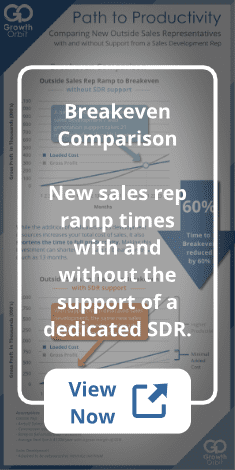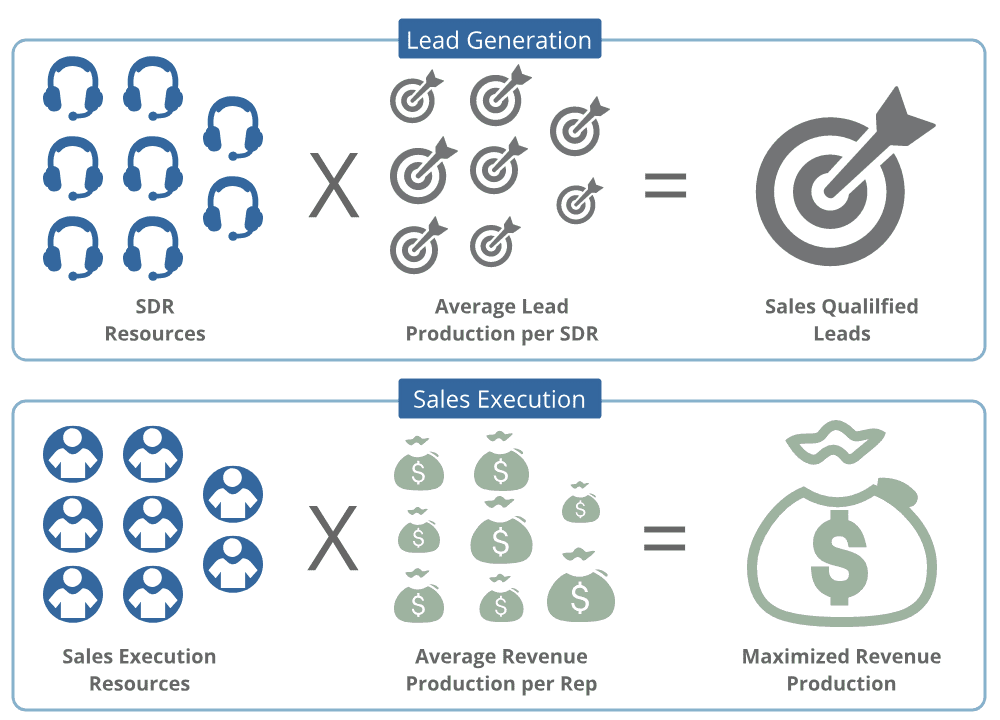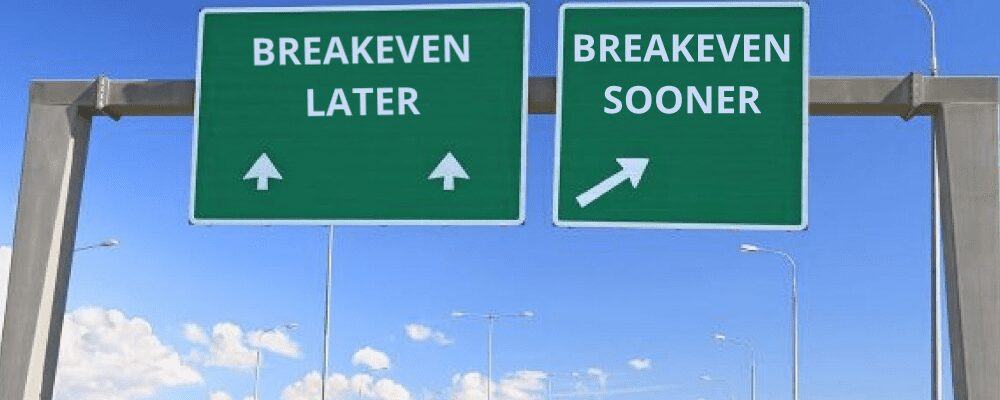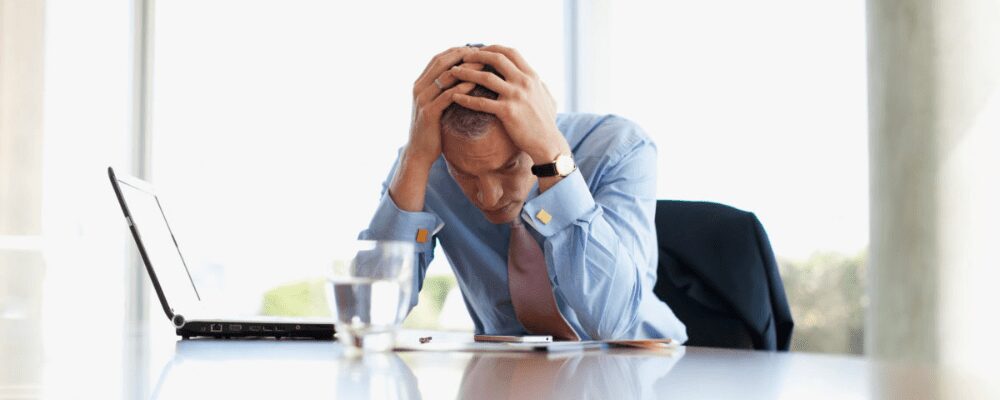It is time to restructure your sales organization
Growth Orbit Insights
I have a confession to make. For many years I had a simple formula for growth that I now know was seriously flawed. I knew what I could expect a typical salesperson to produce on a monthly basis, how long they took to fully ramp and thus I simply had to divide my needed revenue productions by the average rep production to get the number of reps I needed to hit my number. I would plan for the appropriate ramp time, factor in some performance fallout or churn and I had my plan. It took years before I figured out there was a better way. A way to get ramped quicker, produce more top-line growth and all at a lower cost. Here is how.
by Steve Schilling
What is your formula?
In the current economic environment, sales leaders continue to struggle to find the right balance between managing the bottom-line to navigate today’s realities, while investing in top-line growth for tomorrow. Many organizations used the recent business downturn to cut loose their under-performing sales reps and are now staffed below what they expect is needed to achieve their sales plan. Now faced with market uncertainties, tightened budgets and the challenges of ramping new sales resources, the decision to hire more sales reps is a challenging one. But maybe there is a better formula. A different choice to make.
“Coffee is for closers.” Alec Baldwin’s character famously says this in the film Glengarry Glen Ross. ABC, Always Be Closing is a mantra of sales, it is what we think good salespeople are all about. There are books written on the subject, classes taught, and interviews structured around identifying the trait in potential new hires… “She’s a closer!” Regardless of your view on the importance of “closing skills,” in the complexed sales arena a lot has to happen before the opportunity to close even comes into play. And many of these early-funnel activities are not the strong suit for the majority of today’s sales reps.
First, send in the leads?
 HubSpot has found that the average close rate across all industries is 19%. So an average sales rep needs five qualified opportunities to get one win. The data on lead rates based on prospecting activity varies greatly depending on industry and target market. Let’s assume a 4% lead rate for our exercise here. To find and qualify five opportunities a salesperson is going to need to engage 125 prospects. With an aggressive prospecting strategy, including approximately 80 phone calls a day, plus emails, voicemails and social selling, a disciplined, capable sales rep supported by the right tech stack should be able to achieve that level of engagement in a month of effort. [See breakeven comparison for the detailed math]
HubSpot has found that the average close rate across all industries is 19%. So an average sales rep needs five qualified opportunities to get one win. The data on lead rates based on prospecting activity varies greatly depending on industry and target market. Let’s assume a 4% lead rate for our exercise here. To find and qualify five opportunities a salesperson is going to need to engage 125 prospects. With an aggressive prospecting strategy, including approximately 80 phone calls a day, plus emails, voicemails and social selling, a disciplined, capable sales rep supported by the right tech stack should be able to achieve that level of engagement in a month of effort. [See breakeven comparison for the detailed math]
To recap, a dedicated and driven salesperson with the right skills and technology, working full time prospecting should be able, over the course of a month, to develop 5 sales qualified leads. The challenge is, for 95% of the salespeople out there, this isn’t going to happen. It isn’t what they were trained to do, it isn’t what they were hired to do, it isn’t what they are good at and it certainly isn’t what they enjoy. But in the current environment it is what is required.
It gets worse. Would it surprise you to learn that much of a salesperson’s time isn’t spent on selling at all? Sales reps report they only spend one-third of their time selling. That means 65% of the time is spent on non-revenue generating activities (meetings, research, updating Salesforce.com). No wonder they are not making plan. So now what?
There is a better way
As the world has evolved through time it has consistently evolved towards specialization. We see this in everything from manufacturing to medicine. The same necessity exists within sales. We have already established that the typical salesperson doesn’t like prospecting, isn’t typically very good at it and doesn’t spend the necessary time at it to be successful. The absolute opposite is true of a typical Sales Development Rep (SDR). While a typical sales rep spends only one-third of their time selling (and a small fraction of that prospecting), an average sales development rep spends 85-90% of their time prospecting. It is their specialty.
This piece opened with my old, flawed, revenue growth formula:

As long as I had enough fully ramped reps, I should hit my number. But that is a big IF, especially now when we have all lost many of the traditional selling avenues our sales teams have become accustomed to. Many sales opportunities have pushed due to the current market uncertainty. Sales teams are experiencing more customer churn and budget-driven sales rep turnover. All of this contributes to sales pipelines and forecasts being in jeopardy.
Sales organizations everywhere are now behind on their revenue growth plans and looking for how to get back on track. This is the shortcoming of my formula. To correct this flaw, we need to account for turnover, ramp times and market challenges. We need to ensure the team is at maximum productive capacity.
The case for dedicated sales development
To solve the shortcoming in my revenue formula and get revenue growth back on track we need to do the following:
1. Shorten the ramp to full productivity
2. Align and optimize performance, and
3. Improve all-around productivity
The solution is dedicated sales development resources or SDRs. Let’s take a closer look at the reasons why:
1. While a typical B2B salesperson, in a complex sales arena, takes 6-8 months or more to fully ramp, a typical SDR takes 3 months or less. So, it takes a SDR half the time to reach full productivity versus a traditional sales rep.
2. They also cost less. The typical outside salesperson’s salary ranges from $50k to $80K, according to payscale.com, plus commissions and bonuses. Inside sales positions typically cost 25% less.
3. An SDR is focused on the front-end of the sales process, generating leads. An outside rep is focused on opportunity development, closing and account development, all of which comes after lead development.
Focusing on total sales team productivity without including sales development in the equation is literally putting the cart before the horse.
Managing the Optimized Performance Formula
Optimizing your sales organization for maximum performance at the lowest operating cost is an exercise is achieving the right resources in the right numbers that are appropriately balanced to maximize your results.
If your organization is falling short of plan, before considering hiring new outside sales reps, first look to maximize the productivity of your current team. Play to their strengths by ensuring their funnels are full of sales qualified leads. The fastest, most cost-effective way to achieve this is with lead generation specialist – Sales Development Reps.
Once your outside sales team has full, well-balanced funnels and are managing all of the activity they are capable of, it is time to look to expand your outside sales team. By utilizing this approach, you will hire outside reps into an active flow of sales qualified leads. This will shorten the ramp time your outside sales reps require as well, since they can engage with prospects early in their ramp period and get more “at bats” sooner.
But wait there is more...
This approach to optimizing your sales organization doesn’t just provide improved performance, it provides additional benefits as well.
1. Recruiting benefits: Sales reps want to work in an environment where they have the best chance to succeed. The fact you are investing in a dedicated sales development effort to ensure your reps have the most opportunities in front of qualified prospects will be a differentiator for your organization during the recruiting process.
2. Retention benefits: By providing sales qualified leads you are setting your reps up for success, putting them in a position to do what they do best more frequently. You can ask for and expect higher levels of performance. Inevitably leading to happier, higher performing sales reps which are less likely to seek employment elsewhere.
3. Development benefits: A sales development organization (regardless if it is inhouse or outsourced) can provide a critical “farm team” to develop your next generation outside sales team. This provides career pathing for your SDR team, which improves recruiting, gives better visibility into the capabilities of your emerging outside reps and can lower your cost of talent as you are developing your own outside team.
4. Lower operating cost: Sales development reps ramp quicker than outside reps and shorten the ramp for outside reps by feeding their funnels with sales qualified leads. When you achieve the correct balance of these resources you will achieve a lower overall cost of sales than a sales organization built solely on outside reps.
Why restructure your sales organization
Leading CRO’s, CSO’s and other owners of top-line revenue growth operate differently than the pack. They aren’t “big game hunters,” relationship guys and gals, solely focused on sales wins or even sales activity. They focus on building an optimized sales organization, that has appropriate specialization designed to maximize its productive revenue growth capacity. That formula looks like this:

If you understand this formulaic approach and carefully track these key variables, at any point in time you can calculate your productive revenue growth capacity and scale up and down as you need.
Getting your assumptions right on these variables will be the key if you want to consistently hit your numbers. Sales leadership’s #1 job is to recruit, ramp and maintain sales resources on time so that they always have the right amount of productive sales capacity. If you can predict sales, not by looking at deals in the pipeline, but by looking at your sales capacity, you have mastered this concept and achieved a predictable revenue growth formula!
Frequently Asked Questions about Restructuring your Sales Organization
What are the initial steps to take when considering the restructuring of a sales organization?
When considering restructuring a sales organization, the initial steps should include conducting a thorough analysis of the current sales process to identify inefficiencies and areas for improvement. It’s crucial to evaluate the alignment between your sales strategies and overall business goals, assess the skill sets of your current sales team, and understand the changing dynamics of your market. Additionally, gathering input from stakeholders across the organization can provide diverse insights for a comprehensive restructuring plan.
How do you measure the effectiveness of a restructured sales organization?
Measuring the effectiveness of a restructured sales organization involves tracking key performance indicators (KPIs) such as sales revenue growth, lead conversion rates, customer acquisition costs, and sales cycle lengths. It’s also important to monitor sales team morale and productivity, as these can be indicators of the success of the restructuring efforts. Regularly reviewing these metrics against your set objectives will help you understand the impact of your restructuring and allow for timely adjustments.
Can restructuring a sales organization help in adapting to digital transformation challenges?
Yes, restructuring a sales organization can significantly help in adapting to digital transformation challenges. By realigning your sales team structure, processes, and strategies to leverage digital tools and platforms, you can improve efficiency, reach more prospects, and better meet customer expectations in a digital age. This might include integrating new sales technologies, adopting data-driven sales approaches, or developing digital sales channels.
How does a Sales Development Representative (SDR) team complement the efforts of traditional sales reps in a technology company?
An SDR team complements the efforts of traditional sales reps by focusing on the early stages of the sales process, such as prospecting and qualifying leads. This allows the traditional sales reps to concentrate on developing opportunities and closing deals. In technology companies, where selling complex solutions requires deep knowledge and a consultative approach, SDRs can ensure that sales reps are engaging with well-qualified leads, thus improving efficiency and potentially shortening the sales cycle.
What role does specialized training play in the success of a restructured sales organization?
Specialized training plays a critical role in the success of a restructured sales organization, especially in technology companies where products and solutions can be complex. Training ensures that sales teams are equipped with the latest industry knowledge, understand the unique value proposition of their offerings, and are proficient in using new sales tools and technologies. It also helps in aligning the team with the new sales processes and methodologies introduced during the restructuring, thereby enhancing overall performance and effectiveness.
How does restructuring impact the cost-efficiency of a sales organization?
Restructuring can significantly impact the cost-efficiency of a sales organization by optimizing resource allocation, eliminating redundancies, and enhancing productivity. By aligning the sales team structure with strategic business goals and market demands, companies can ensure that their sales efforts are focused on high-value activities. The introduction of roles like SDRs can reduce the cost of acquiring leads and free up experienced sales reps to focus on closing deals, ultimately leading to a better ROI on sales investments.
About Growth Orbit
Growth Orbit is a full-service growth acceleration firm, focused on driving measurable value through lead generation and sales performance solutions that work. We excel at combining sound growth strategy with proven sales methodologies, supported by effective technology. We only consider ourselves successful when we deliver accelerated, measurable growth for our clients.
From developing smart insight driven sales messaging, to filling your funnel with qualified leads, we’ve built our foundation on meeting clients where they are and helping them achieve new levels of growth — what we call reaching Growth Orbit!




